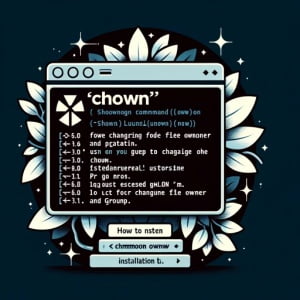Mastering Linux: How to Install and Use ‘chown’

Are you struggling with changing file ownership in Linux? The ‘chown’ command is a handy tool that can make this task a breeze. However, for many Linux users, especially beginners, installing and using Linux commands can seem a bit daunting. But don’t worry, the ‘chown’ command is widely available on most package management systems, making the installation process straightforward once you know the steps.
In this comprehensive guide, we will walk you through the process of installing and using the ‘chown’ command in Linux. We will provide instructions for both APT (Debian and Ubuntu) and YUM-based distributions (CentOS and AlmaLinux), delve into compiling ‘chown’ from source, installing a specific version, and finally, how to use the ‘chown’ command and verify that the correct version is installed.
So, let’s dive in and start mastering the ‘chown’ command in Linux!
TL;DR: How Do I Install and Use the ‘chown’ Command in Linux?
The
'chown'command typically comes pre-installed on most Linux distributions, you can verify this with,chown --version. If for some reason it isn’t installed, you can add it via the coreutils package and the command,sudo [apt-get/yum] install coreutils. To use it, you can run the commandsudo chown [new-owner]:[new-group] [file-name].
sudo chown john:developers myfile.txt
# Output:
# Changes the ownership of 'myfile.txt' to user 'john' and group 'developers'
This is just a basic way to use the ‘chown’ command in Linux, but there’s much more to learn about ‘chown’ and its various applications. Continue reading for a more detailed guide and advanced usage scenarios.
Table of Contents
- Understanding and Installing the ‘chown’ Command
- Installing ‘chown’ from Source Code
- Installing Different Versions of ‘chown’
- Using ‘chown’ and Verifying Installation
- Alternative Methods for Changing File Ownership
- Troubleshooting ‘chown’ Command Issues
- Considerations When Using ‘chown’
- Understanding File Ownership in Linux
- The Relevance of File Ownership in System Administration and Security
- Wrapping Up: Installing the ‘chown’ Command in Linux
Understanding and Installing the ‘chown’ Command
The ‘chown’ command is an essential tool in Linux used for changing the ownership of files and directories. It’s a crucial command for system administrators and users who need to manage file permissions and access on a Linux system. It’s versatile and powerful, allowing you to change the owner and group of a file or directory swiftly.
Installing ‘chown’ with APT
If you’re using a Debian-based Linux distribution like Ubuntu, the ‘chown’ command is generally pre-installed. However, if for some reason it’s not, you can install it using the Advanced Packaging Tool (APT) with the following command:
sudo apt-get update
sudo apt-get install coreutils
# Output:
# The 'chown' command is a part of the 'coreutils' package, so installing 'coreutils' will also install 'chown' if it's not already installed.
Installing ‘chown’ with YUM
For CentOS, Fedora, or other RedHat-based distributions, the ‘chown’ command comes with the ‘coreutils’ package, which is typically pre-installed. If not, you can use the Yellowdog Updater, Modified (YUM) to install it:
sudo yum update
sudo yum install coreutils
# Output:
# This will install the 'coreutils' package, which includes the 'chown' command.
Installing ‘chown’ with Pacman
In Arch Linux and its derivatives, the ‘chown’ command can be installed using the Pacman package manager. The command is part of the ‘coreutils’ package in these distributions as well.
sudo pacman -Syu
sudo pacman -S coreutils
# Output:
# This will update your system and install the 'coreutils' package, including the 'chown' command.
After the installation, you can verify the presence of the ‘chown’ command by typing chown --version in your terminal. This command will display the version of ‘chown’ installed on your system.
Installing ‘chown’ from Source Code
For advanced users or those who need a specific version of ‘chown’, installing from source code is an option. This requires more steps and understanding of the Linux command line.
wget http://ftp.gnu.org/gnu/coreutils/coreutils-8.32.tar.xz
# Output:
# Downloads the 'coreutils' source code package
tar -xvf coreutils-8.32.tar.xz
# Output:
# Unpacks the downloaded package
cd coreutils-8.32
# Output:
# Changes the directory to the unpacked source code folder
./configure
make
sudo make install
# Output:
# Configures, compiles, and installs the 'coreutils' package, which includes 'chown'
Installing Different Versions of ‘chown’
The ‘chown’ command has undergone several revisions, each introducing new features, bug fixes, or compatibility updates. Depending on your specific needs, you might need to install a different version of ‘chown’.
Installing Different Versions from Source
To install a different version of ‘chown’ from source, you just need to change the version number in the download link. For example, to download version 8.31, you would replace ‘8.32’ with ‘8.31’ in the wget command.
Installing Different Versions with APT or YUM
When using a package manager like APT or YUM, you can specify the version number during installation. However, not all versions may be available in the package manager’s repository. You can check the available versions with the ‘apt policy’ or ‘yum list –showduplicates’ commands.
APT Version Installation
sudo apt-get install coreutils=8.31*
# Output:
# Attempts to install version 8.31 of 'coreutils'
YUM Version Installation
sudo yum install coreutils-8.31*
# Output:
# Attempts to install version 8.31 of 'coreutils'
Version Differences
Each version of ‘chown’ introduces changes that might be beneficial or necessary for your specific use case. For instance, version 8.32 introduced a new feature that allows changing the ownership of symbolic links, while version 8.31 fixed a bug related to file permission changes.
| Version | Key Changes |
|---|---|
| 8.32 | Added support for changing symbolic link ownership |
| 8.31 | Fixed a file permission bug |
Using ‘chown’ and Verifying Installation
Basic ‘chown’ Usage
Once ‘chown’ is installed, you can change the ownership of files and directories. Here’s an example of changing the owner of a directory and all its contents:
sudo chown -R john:developers /path/to/directory
# Output:
# Changes the ownership of '/path/to/directory' and all its contents to user 'john' and group 'developers'
Verifying ‘chown’ Installation
After installing ‘chown’, you can verify its installation and version by running the following command:
chown --version
# Output:
# Displays the version of 'chown' installed on your system
This command should output the version of ‘chown’ installed, confirming that the installation was successful.
Alternative Methods for Changing File Ownership
While ‘chown’ is a powerful command for managing file ownership in Linux, it’s not the only tool at your disposal. Other commands, like ‘chmod’, can also be used to manage file permissions and ownership. Let’s explore some of these alternatives.
Using ‘chmod’ to Change File Permissions
The ‘chmod’ command is used to change the permissions of a file or directory. While it doesn’t directly change the owner, it can modify who has access to the file or directory and what they can do.
Here’s an example of changing the permissions of a file using ‘chmod’:
chmod 755 myfile.txt
# Output:
# Changes the permissions of 'myfile.txt' to '755', which means the owner can read, write, and execute the file, while others can only read and execute it.
In this example, ‘755’ is an octal number representing the file’s permissions. The first digit represents the owner’s permissions, the second represents the group’s permissions, and the third represents everyone else’s permissions. Each digit can be a number from 0 to 7, with 7 meaning full permissions (read, write, and execute), 6 meaning read and write permissions, 5 meaning read and execute permissions, and so on.
Advantages and Disadvantages of ‘chmod’
While ‘chmod’ is a powerful tool, it’s not always the best choice for changing file ownership. Here are some advantages and disadvantages to consider:
Advantages of ‘chmod’
- ‘chmod’ allows for fine-grained control over file permissions.
- It can change the permissions of multiple files or directories at once.
Disadvantages of ‘chmod’
- ‘chmod’ doesn’t directly change the owner or group of a file or directory.
- It can be complex to use, especially for beginners.
Recommendations
If you need to change the owner or group of a file or directory, ‘chown’ is generally the best tool for the job. However, if you need to change the permissions of a file or directory, ‘chmod’ can be a better choice. Always consider your specific needs and the tools available to you when managing file ownership and permissions in Linux.
Troubleshooting ‘chown’ Command Issues
While the ‘chown’ command is a powerful tool, users may encounter issues when using it. Let’s discuss some common problems and their solutions.
Permission Denied Error
One common issue is the ‘Permission denied’ error. This error occurs when you try to change the ownership of a file or directory without the necessary permissions. To solve this issue, you can use the ‘sudo’ command to run ‘chown’ as the root user.
sudo chown john:developers myfile.txt
# Output:
# Changes the ownership of 'myfile.txt' to user 'john' and group 'developers' with root privileges
Invalid User or Group Error
Another common issue is the ‘invalid user’ or ‘invalid group’ error. This error happens when you try to change the ownership to a user or group that doesn’t exist on your system. To fix this, you can create the user or group with the ‘useradd’ or ‘groupadd’ command before running ‘chown’.
sudo useradd john
sudo groupadd developers
sudo chown john:developers myfile.txt
# Output:
# Creates user 'john' and group 'developers', then changes the ownership of 'myfile.txt' to user 'john' and group 'developers'
File or Directory Does Not Exist Error
The ‘No such file or directory’ error occurs when the file or directory you’re trying to change the ownership of doesn’t exist. Make sure to check the file or directory path and name before running the ‘chown’ command.
ls
# Output:
# Lists the files and directories in the current directory
sudo chown john:developers myfile.txt
# Output:
# Changes the ownership of 'myfile.txt' to user 'john' and group 'developers' if 'myfile.txt' exists in the current directory
Considerations When Using ‘chown’
While ‘chown’ is a powerful command, it’s important to use it responsibly. Changing the ownership of a file or directory can have significant effects on your system’s security and functionality. Always double-check the user, group, and file or directory before running the ‘chown’ command, and consider the potential consequences of the change.
Understanding File Ownership in Linux
In Linux, every file and directory is assigned three types of owner, namely the user, the group, and others. The user is the owner of the file. A group contains multiple users, all of which share the same access permissions as those granted to the group. Lastly, others imply users that are not part of the group.
Importance of File Ownership
File ownership is crucial in a Linux environment as it determines who can read, write, or execute a file. This is a fundamental aspect of Linux security and is essential to prevent unauthorized access or modifications to system files.
ls -l myfile.txt
# Output:
# -rw-r--r-- 1 john developers 2048 Jan 1 12:34 myfile.txt
In the above example, the -rw-r--r-- part shows the file permissions, john is the user, developers is the group, and 2048 Jan 1 12:34 myfile.txt is the file size, modification time, and file name, respectively.
Understanding Linux Permissions
In Linux, permissions are represented as a set of three characters for the user, the group, and others, in that order. Each character can be either r (read), w (write), x (execute), or - (no permission). For example, rw- means the user can read and write the file but cannot execute it.
chmod u=rw,g=r,o=r myfile.txt
# Output:
# Changes the permissions of 'myfile.txt' to 'rw-r--r--'
In this example, we’re using the chmod command to set the user (u) permissions to read and write (rw), the group (g) permissions to read (r), and the others (o) permissions to read (r).
How ‘chown’ Works
The ‘chown’ command changes the user and/or group ownership of a given file or directory. The syntax is chown [OPTIONS] USER[:GROUP] FILE.... The USER and GROUP are the new owner and group, and FILE is the file or directory you want to change.
sudo chown john:developers myfile.txt
# Output:
# Changes the ownership of 'myfile.txt' to user 'john' and group 'developers'
In this example, we’re using ‘chown’ to change the user to ‘john’ and the group to ‘developers’ for ‘myfile.txt’.
The Relevance of File Ownership in System Administration and Security
Understanding file ownership in Linux is crucial for system administration and security. It’s a fundamental aspect of Linux that affects access to resources and system operations. Incorrect file ownership can result in unauthorized access or the inability to access necessary files.
For instance, if a critical system file is owned by a regular user, that user could modify or delete the file, potentially causing system instability. On the other hand, if a file that the user needs to modify is owned by the root user, the regular user might not be able to make necessary changes.
ls -l /etc/passwd
# Output:
# -rw-r--r-- 1 root root 2389 Dec 7 09:57 /etc/passwd
In this example, the /etc/passwd file, which stores user account information, is owned by the root user. This ownership prevents regular users from modifying the file, enhancing system security.
Exploring Related Concepts: File Permissions and User Groups
In addition to file ownership, Linux has other related concepts like file permissions and user groups. These concepts are interrelated and crucial for managing access to files and directories in Linux.
File permissions determine who can read, write, and execute a file or directory. They are set for the user, the group, and others. User groups are a way of grouping users that have the same access permissions.
Using these concepts effectively can enhance your system’s security and ease of use. For example, you can set up a user group for developers and give them write access to the project directories, while restricting access to other users.
sudo groupadd developers
sudo chown :developers /path/to/project
sudo chmod 775 /path/to/project
# Output:
# Creates a 'developers' group, changes the group ownership of the project directory to 'developers', and sets the directory permissions to '775', which allows the group to read, write, and execute the files in the directory.
Further Resources for Mastering Linux File Ownership
To deepen your understanding of file ownership and related concepts in Linux, here are some resources you can explore:
- Linux File Permissions Tutorial: This tutorial provides an in-depth look at file permissions in Linux, including how to set and modify them.
The Linux System Administrator’s Guide: This guide covers a wide range of topics related to system administration in Linux, including file ownership and permissions.
Linux Security Tips: This guide discusses various aspects of securing your Linux workstation.
Wrapping Up: Installing the ‘chown’ Command in Linux
In this comprehensive guide, we’ve delved into the intricacies of the ‘chown’ command in Linux, a versatile tool for managing file ownership.
We began with the basics, discussing how to install and use ‘chown’ in various Linux distributions. We then tackled more advanced topics, such as installing ‘chown’ from source and handling different versions of the command. Alongside, we provided code examples to help you understand and apply these concepts practically.
Navigating through potential challenges, we addressed common issues that users might encounter when using ‘chown’, such as permission denied errors, invalid user or group errors, and non-existent file or directory errors. We provided solutions and tips to help you overcome these challenges and use ‘chown’ effectively.
We also explored alternative methods for changing file ownership in Linux, such as the ‘chmod’ command, giving you a broader perspective on managing file permissions. Here’s a quick comparison of these methods:
| Method | Directly Changes Ownership | Changes Permissions |
|---|---|---|
| ‘chown’ | Yes | No |
| ‘chmod’ | No | Yes |
Whether you’re just starting out with Linux or you’re an experienced system administrator, we hope this guide has given you a deeper understanding of the ‘chown’ command and its importance in managing file ownership.
With its range of functionalities, ‘chown’ is an essential tool for any Linux user. It empowers you to manage file ownership effectively, enhancing your control over system security and operations. Happy coding!


